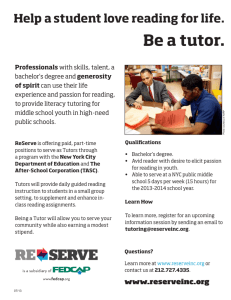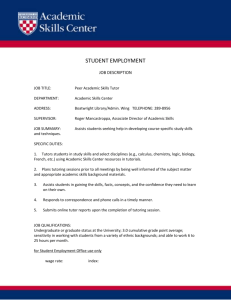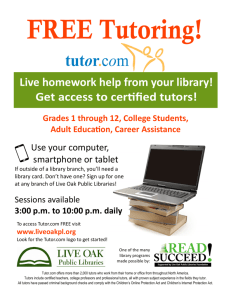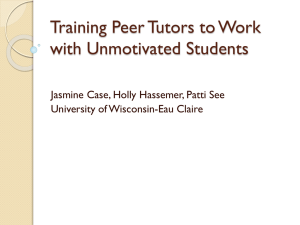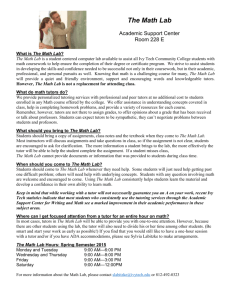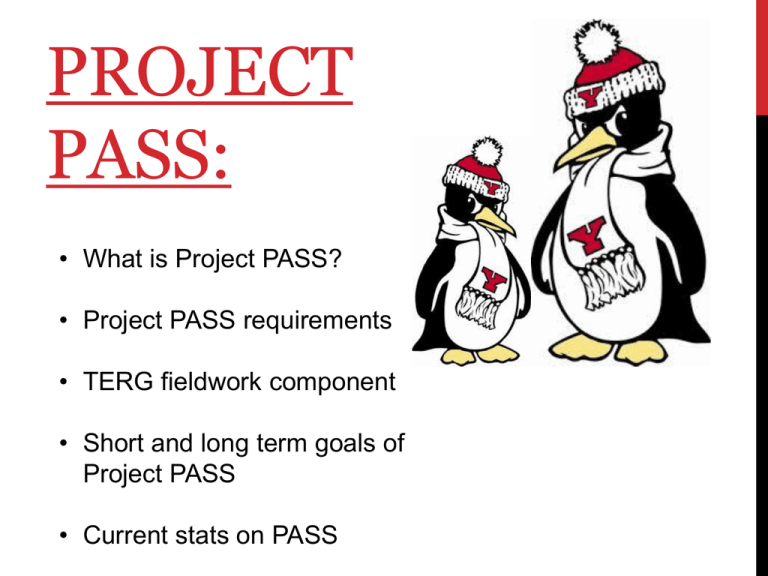
PROJECT
PASS:
• What is Project PASS?
• Project PASS requirements
• TERG fieldwork component
• Short and long term goals of
Project PASS
• Current stats on PASS
PASS FACTS:
McGuffey
85%
64 students with tutors
Taft
100%
48 students with tutors
Bunn
92%
33 students with tutors
MLK
73%
37 students with tutors
Williamson
94%
47 students with tutors
Harding
97%
59 students with tutors
Overall
As of 5/19/15
90% of all teacher requested YCS
second -graders have YSU tutors
288 YCS second- graders have
YSU Tutors
Spring 2015
Summer 2015
8,640
2,147
Fall 2015
Spring 2016
Prior to Fall 2015 over 10,000 hours of one-on-one literacy
tutoring has been provided!
APPLICATION PROCESS:
Name:
Date applicant was placed _____________
Email:
Phone:
Major:
TERG courses completed Note: Completion of TERG courses is not required, but will affect the type of training
provided to you. (Course #, semester taken, and grade)
Current TERG:
Current Professor: ____________________________
Student(s) Name/YCS School & teacher
Student ID: Y00
*Note the semesters the tutor was with the
student S15, X15, F15, S16
Current GPA:
Accepted to Upper Division? ____ Yes ____ No
Note: Not required for acceptance into the program
I would like to tutor one student ______ two students______
Availability:
8:00-9:00 ______
11:45-12:45 _____
12:00-12:55 _____
1:00-3:00 _________
________________________
________________________
________________________
________________________
________________________
________________________
________________________
____________________
___________________
PLEASE select at least 2 time slots so we can accommodate your schedule
I understand to be eligible for the scholarship, that Project PASS is a commitment that will be carried over until
my student(s) takes their third-grade state assessment. X _______________________________
Additional Notes:
Placed by: __________________________________
ADDITIONAL FACTS ON PASS
•
To date
over 10,500 hours of one-on-one literacy tutoring has been provided
•
YSU tutors have volunteered to attend and assist with YCS literacy nights
•
Tutors are building home literacy lessons for whole family literacy growth. Bringing literacy into the home by
providing pre-made lessons, manipulatives and books.
•
ongoing monthly professional development on literacy best practices
•
Over 525 people are directly involved in the development and execution of Project PASS
•
OERC will be collecting data and evaluating the success of Project PASS
•
YSU students are stating that they feel more invested in their student’s success and have a better
understanding of their student’s literacy needs
•
YSU students focus on 3 main areas: reading comprehension, fluency, and writing
Project PASS takes classroom learning to realworld application
PROJECT PASS
•
WHAT IS PROJECT PASS?
•
WHAT ARE THE REQUIREMENTS?
•
WHERE CAN I ACCESS MORE
INFORMATION?
PROJECT PASS
Project PASS website:
http://projectpass.weebly.com/
important reminders
upcoming professional developments
documents and resources
contact information
PROJECT PASS
REMIND 101
Sign up for remind 101
Project PASS is now using REMIND 101 to better increase
communication. Please sign up if you would like text alerts regarding
Project PASS
To receive messages via text ,
text @passysu to 81010
The link to REMIND 101 is also on the PASS website
PROJECT PASS
Dr. Saunders-Smith
gasaunderssmith@ysu.edu
330.941.1353
Office:
2208 BCOE
PROFESSIONALISM FOR YSU TEACHER
CANDIDATES:
Attire
Cell phones
Being prepared
Conforming to the school climate and rules
Quality of work
PROFESSIONALISM IN
THE SCHOOLS
Relationships
NO physical contact
Only a school based program
Where to tutor? Acceptable locations?
Act as guests
Appreciation towards the teacher, secretary, school administration
CALL OFF
PROCEDURE:
Email the GA who is the point of contact for the YCS in which
you tutor
The email should be sent prior to your scheduled tutoring time
The email should include:
-time/date you are scheduled to tutor
-Name of the student you tutor
-Brief reason why you are unable to tutor and confirm your next
scheduled tutoring session
-An email to the classroom teacher of the student is also
necessary
EXAMPLE: CALL OFF
EMAIL TO GA
I am unable to tutor Billy Madison today,
Tuesday, August 11th at 8:30, due to an
unexpected illness. I tutor from 8:30-9:30 at
McGuffey Elementary School on Tuesdays and
Thursdays. I plan on being back Thursday for
my tutoring session with him.
I will also send his teacher, Mrs. Green an
email notifying her of my absence.
Thank you,
Pete Penguin
PROJECT PASS
YSU Student
YCS Building
YSU TERG____________________________
YCS Student
YCS Teacher
YSU instructor:________________________
Date
Materials
Time in
Time out
Activities
Hours
What worked / What didn’t work / What happens next / Implications for teaching
Date
Materials
Time in
Time out
Activities
Hours
What worked / What didn’t work / What happens next / Implications for teaching
PASS Logs Rubric
The quality of the logs will be measured using the following rubric. Thirty points are possible for completing the
logs. The total number of points earned will be determined using the range of quality on the following traits.
08-15
Unsatisfactory 3 pts.
Satisfactory 4 pts.
Competent 5 pts.
Materials are not listed.
Materials are listed for some of the
lessons.
Various types of materials are listed for
most lessons. Materials include reading
to and with the child.
Various types of materials are listed
representing each segment of the lesson.
Specific books are identified for reading
to, with, and by the child. Writing
materials are identified. Hands-on
materials are identified.
Few or no reading, writing,
comprehension, and phonics activities
are described in.
Some reading, writing,
comprehension, and phonics activities
are described in detail.
Most reading, writing, comprehension,
and phonics activities are described in
detail as to who will do what and what is
expected from the student. Steps for each
activity are provided.
Each reading, writing, comprehension,
and phonics activity is described in detail
as to who will do what and what is
expected from the student. Steps for each
activity are provided.
Few or no books or games are cited;
or, incorrect citations are used.
Some books and/or games are cited;
or, incorrect citations are used.
Most books and/or games are correctly
cited using APA 6th ed.
Each book and/or game is correctly cited
using APA 6th ed.
Reflections include few or no details
of activities.
Reflections include details for some
of the activities. Details include
specifics of what worked and what
didn’t work.
Reflections include details for most of the
activities. Details include specifics of
what worked and what didn’t work
including an explanation of why. A
projection of what should happen next
details how the lesson should be revised
to improve student performance.
Reflections include details for each of the
activities. Details include specifics of
what worked and what didn’t work
including an explanation of why. A
projection of what should happen next
details how the lesson should be revised
to improve student performance.
Few or no details for activities are
included.
Details for some of the activities are
included.
Details for most of the activities are
included.
Specific details for each activity are
included such as the writing prompt being
used; the phonics element being
addressed in the lesson; and, the type of
reading being done.
Materials
Activities
APA
Reflection
Thoroughness
Exemplary 6 pts.
Total
TEACHER TALK AND
HIGHER LEVEL
QUESTIONS
Content LevelStrategy level-
Inquiry vs MetacognitionTypes of questions-
Reference teacher talk guide sheet
Interactive Read-Aloud
What it is
An interactive read-aloud occurs when a reader reads a book to a
listener or a group of listeners. The purpose of an interactive read-aloud
is to engage the listener in a conversation that gives the listener
opportunities to think and talk about the book’s content. The reader uses
a fiction or nonfiction book that is too difficult for the listener to read by him- or herself. The
book should have pictures and be read in one or several sittings.
Selection and Preparation
1. Select a book that is short enough to read in one session. Use information from the
student’s interest inventory and/or that month’s literacy statement. Read the book before
you decide to use it.
2. As you read the book to yourself, think about what the reader will learn from the book.
What is the book about? Books are about ideas, not characters. For example, Charlotte’s
Web (White, 1949) is a book about friendship, not a book about a pig or a spider or living
on a farm. On a sticky-note, write what you will say to the child about the book’s main
idea or theme. You will tell the child what the book is about. Do not ask him or her,
“What do you think this book is going to be about?” He/she doesn’t’ know so don’t
make him/her guess. Talk with the child about the main idea. For example, if you will
read a book about being friends say, “I bet you have a friend. Who is your friend?” Keep
this conversation short. Put the sticky-note on the cover of the book.
3. As you read the book to yourself, determine what you will say about the author and
illustrator since you will say something about them. If you don’t know anything, make up
something. For example, “E. B. White is the author of this book. He knows a lot about
being friends.” “Garth Williams is the illustrator. He used pen and ink for these
drawings.” Use what you know or can deduce from reading the book and examining the
illustrations. Write what you will say on a sticky-note and put it on the cover.
4. As you read the book to yourself, look for one or two places where you will stop and talk
with the child about what is happening, or have the child make a prediction, or have the
child make a connection. For example, find a spot where you might ask the child, “Why
do you think he did that?” Or, “What else could he have done?” Or, “When did
something like that happen to you?” On a sticky-note, write what you will say to the child
and place the note(s) on the page(s).
5. As you read the book to yourself, determine what genre the book is as you will tell the
child the genre. Put this information on a sticky-note on the cover.
Cut Up Sentences:
Cut-Up Sentence
What It Is
A cut-up sentence is a sentence that is written on a strip of paper using words the child can read.
After reading the sentence, the teacher cuts apart the words and mixes them up, and the child
reconstructs the sentence.
Selection and Preparation
1. Cut sheets of copy paper landscape (horizontally, wide-way) into two-inch strips. You
can probably get four or five strips from a sheet of paper. You can also cut adding
machine tape into seven- or eight-inch strips. Cut a bunch of strips to have on hand.
2. As the child reads to you, be watching for words to include in a sentence. You might
think of a sentence that goes with the book – perhaps about one of the characters, the
setting, or something that happened; or the sentence might be about something other than
the book.
3. Using words that the child already knows, write a sentence with a marker (using your
best teacher printing) on a strip of copy paper or a strip of adding machine tape. You can
prepare several sentences using a different color marker for each sentence.
4. For a child who is an able reader, try writing a short paragraph using several sentences.
Use a different color marker for each sentence and write on an unlined sheet of paper.
Leave enough room between the lines so that you can cut apart the lines and words.
5. Each sentence will need to have an envelope or a plastic snack bag to keep the words.
HEARING AND
RECORDING SOUNDS IN
WORDS
Sight Words Reading Assessment: Grade Three
Student Name: ____________________
Assessment Dates: 1st _______________ 2nd _______________ 3rd _______________
1
2 3
about
1
2 3
grow
1
2 3
own
better
hold
pick
bring
hot
seven
carry
hurt
shall
clean
if
show
cut
keep
six
done
kind
small
draw
laugh
start
drink
light
ten
eight
long
today
fall
much
together
far
myself
try
full
never
warm
got
only
INTEREST INVENTORY:
Things that Interest Me!
Circle your answers:
I like it when people read to me: yes no
I like to read books with someone: yes no
I like to read books by myself: yes no
I like to read stories that are : funny happy sad
I like to read stories that are : real make-believe
I read 1 2 3 4 5 6 7 8 9 10 books this summer
Here is the name of a good book:
My favorite toy is... My favorite place to go is...
My favorite t.v. show is... My favorite game is...
All Rights Reserved www.theteacherorganizer.com
Things that Interest Me... part 2!
Write your answers:
1. When I am at home, I like to:
2. When I am with my friends, I like to:
3. These are some things I am good at:
4. I would like to meet this person (they can be real or make-believe):
5. If I had a million dollars I would:
6. When I grow up I would like to:
All Rights
PROJECT PASS
What to do? Materials?
First week
-interest inventory
-sight word assessments(Dolch)
-hearing sounds and words
-interactive read alouds
-Cut up sentences
-journal writing
Build rapport with your student
Create behavior management tools
Set goals
Celebrate when goals are met
All sessions should focus on 3 things: reading comprehension, reading fluency, and writing
COMMON CORE:
Do you know what they need to know?
http://www.corestandards.org/ELA-Literacy/W/3/
3rd grade reading and writing
http://www.sanchezclass.com/readinggraphic-organizers.htm
Graphic Organizers
www.havefunteaching.com/worksheet
s/graphic-organizers/
https://www.superteacherworksheets.com/journal
-prompts.html
-Think of a time when you've won something. Tell what you won and how you won
it.
-Imagine you woke up and saw a dinosaur in your backyard. Write a story telling
what you see and do.
-If you could cook any meal for your family, what would you cook? Describe the
meal and tell how you would make it.
-Imagine you had a hundred dollars, but you couldn't keep it. You had to give it
away to a person or charity. Who would you give it to? What would you want them
to do with it?
https://www.pinterest.com/catalinapline/writing-picture-prompts/
Journal Writing:
ADDITIONAL
RESOURCES:
Common core:
http://www.corestandards.org/ELA-Literacy/RL/3/
Citation Apps:
http://www.easybib.com/products/easybibgoogleapps
https://www.refme.com/i/#below-fold
http://www.calvin.edu/library/knightcite/index.php
http://www.citationmachine.net/apa/cite-a-book
APA APPS:
http://www.internet4classrooms.com/skills-3rd-langbuilders.htm
http://www.funbrain.com/FBSearch.php?Grade=3
http://mrnussbaum.com/third-grade-language-arts/
http://www.studyzone.org/testprep/ela3.cfm
QUESTIONS/CONCERNS?
Success stories….
3 -2 - 1
Three things that are working to the one thing that you are
having difficulty with

